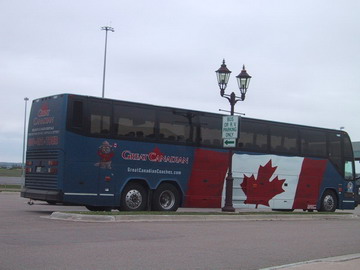- Study in AustraliaAustralian Universities/CollegesPrograms by faculty AusAustralian VisasLife in Australia
- Study In New ZealandNew Zealand UniversitiesPrograms by Faculty NZNew Zealand VisasLife in New Zealand
- Study in CanadaUniversities/Colleges in CANADAPrograms by faculty CanadaCanadian VisasLife in Canada
Transportation
| Transportation | |||
|
Canada is a huge country; it is over 5,000 kilometres (3,000+ miles) from Victoria, British Columbia to St. John's, Newfoundland. That's almost 1,000 kilometres more than the distance between New York, New York to Los Angeles, California! You'll soon find that there are many ways of getting around, both from province to province and within a town or city.
| | ||
 | |||
Overall, Canada has excellent road infrastructure. The TransCanada Highway is the longest national highway in the world; it is almost 8,000 kilometres (5,000 miles) in length. All of the major roads in Canada are paved. People drive on the right side of the road in all provinces and territories. Speed limits are posted on the sides of the road. Generally, highway (freeway) speeds are limited to 100 kilometres/hour, and rural highways are usually limited to speeds of 80 kilometres/hour. Main city roads may have a limit of 60 km/h, and smaller roads usually have a speed limit of 40 km/h. Most people, if they have a driver's license and access to a car, could and would drive to their destination in less than a day if it were less than 600 kilometres away. Driving on main highways with speed limits of 100 km/h, 600 kilometres would about a six-hour drive. No one quite knows why, but many Canadians think in terms of time instead of distance. For example, if you ask "How far is it from Toronto to Montréal?", the answer will often be "About five hours," instead of "About 500 kilometres." Many people drive their cars to and from work during the work week. Traffic during the morning and evening "rush hour", usually between 7 and 9 in the morning and 5 and 7 in the evening, can be quite congested; it can take upwards of an hour to get to or from work. Most large cities in Canada are surrounded by suburbs - these are large urban areas where people live. Many people who live in the suburbs work in the downtown area; when most people begin work between 7 and 9 in the morning, the roads in from the suburbs can get very busy. To conserve gas, money and wear and tear on their cars, many people carpool to and from work. This means that a small group of people drive in the same car, and the passengers pay the driver an agreed-upon amount for gas. Gas in Canada is sold by the litre. (One US gallon is 3.8 litres.) In the last few years, prices have usually varied between 0.66 and 0.77 per litre, but recently, prices have gone as high as $1.00 per litre in BC, and over 0.90/litre in Ontario and Québec. People like to joke that there are only two seasons in Canada: winter and construction. Because of the cold temperatures in the winter, spring through fall is when road work and other construction is done.
If you need a car for a day, weekend, week or two, you might want to look into renting a car. You will want to call and get quotes from a few companies before making your decision. To find rental car companies in your area, look in the Yellow Pages under 'Automobile Renting'. Major rental car companies in Canada include Avis, Budget, Dollar, Enterprise, Hertz, National and Thrifty. Be sure to consult the rental car company's Web site or call them to ask about their policies for renting to people without a Canadian driver's license.
The driving laws may differ slightly in each province or territory. (For example, in Ontario, drivers are allowed to turn right at a red light, unless there is a sign specifically prohibiting it. In Montréal, Québec, drivers are never allowed to turn right on a red light.) Contact the appropriate government agency in your province or territory for a driver's handbook and information about obtaining a provincial or territorial driver's license:
If people prefer not to drive, or don't have the money to take the train, they can take coach buses to go between cities. Greyhound Canada offers Canada-wide service, and Coach Canada offers service in Ontario and Québec.
Biking is popular all over Canada, and some people choose to ride their bicycles to work or school. Bikes can maneuver around cars, and their riders can sometimes arrive at their destination more quickly than those driving cars. People also like to ride their bicycles because it is environmentally friendly and good exercise. Provinces and territories, and sometimes their cities, have laws about bicycle helmets; you should make sure that you know the rules where you're biking in order to avoid paying a fine. Contact the municipal government or city hall of your town or city for information specific to your community. Some cities have bike lanes which are designated bicycle-only lanes, and many cities and towns maintain recreational bike paths and trails that wind through parkland.
If people do not drive, carpool or bike to work, they either walk or take public transportation. Generally, public transit is run by the municipality, city, or town. In larger cities with a lot of commuters, there may also be provincially-run transit such as the GO trains and buses in the Toronto area. In most towns and cities, public transit means buses. Some cities also operate ferries, streetcars, and/or a metro, subway (underground) or elevated train system. Here are links to public transit information in many of Canada's provincial and territorial capitals and other major cities:
Since Canada is such a vast country, sometimes the only way to get from one place to another in hours instead of days is to fly. Canada has one national airline, Air Canada and several regional airlines. Canada has three main international airports:
There are other international airports across the country, but the majority of these only serve flights going to or coming from the mainland United States. We also have several discount airlines, but you shouldn't worry that discount will mean unsafe. Airline safety standards are regulated by Transport Canada. The flights on discount airlines are cheaper because of fewer flights and less in-flight perks such as free drinks and meals. It is well worth the sacrifice to save your money by flying discount. A Selection of Airlines in Canada
VIA Rail serves customers in all regions of Canada from the Atlantic to the Pacific. VIA runs almost 500 trains per week, and is responsible for over 14,000 kilometres of track across the country. VIA's Web site has specific information for non-Canadians: http://www.viarail.ca/planner/en_plan_ncan.html. Learn more about all kinds of transportation in Canada at the Transport Canada Web site: http://www.tc.gc.ca and http://www.tc.gc.ca/aboutus/travel/menu.htm. | |||
For more information, please contact one of our offices
Study in Australia | Study in the UK | Study in Malaysia | Study in Canada | Study in the USA | Study in New Zealand
Editor: Negar Zandipour














